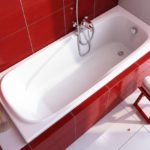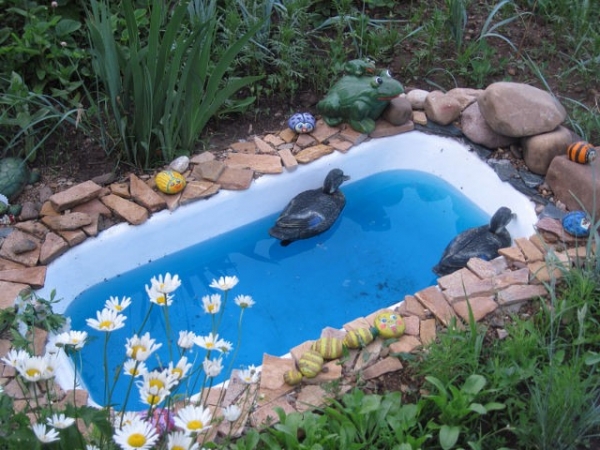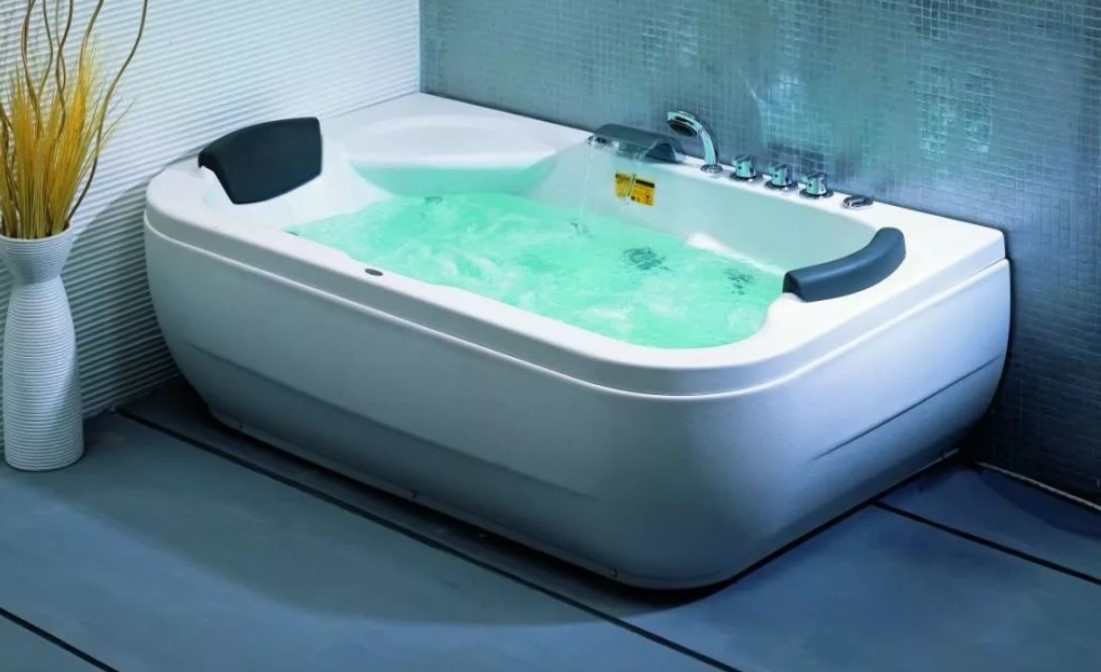How to clean a bathtub?
The appearance of the snow-white bathtub is magnificent - the room shines with cleanliness and freshness! But over time, achieving such an effect becomes difficult: traces of vital activity and the poor quality of tap water spoil the picture. How to achieve crystal clean plumbing without damaging its coating? How to clean a bathtub at home?
The content of the article
Rules for cleaning bathtubs made of different materials
The type of bathtub coating determines the choice of cleaning method and means for its implementation.. Difficulties are inevitable: some household chemicals are too soft to cope with serious contaminants like rust. Others, on the contrary, are able to “eat” the enamel along with the dirt. The situation is similar with the use of a brush: it can irreparably damage the acrylic surface.
Important! A wire brush is not suitable for any bath.
A good old cast iron bathtub can last a long time, but it tends to become covered with microcracks, where dirt can easily penetrate. But it is not capricious in relation to cleaning products - it is also suitable for cleaning washing powder: rub in with a brush, forget for twenty minutes, scrub with a brush or sponge in a circular motion, rinse under running warm water.
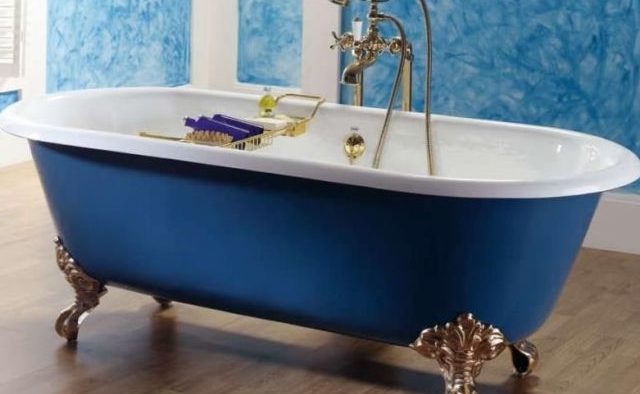
Proven means are also suitable, for example, soda: mix equal parts baking soda and soda ash, apply the mixture to a damp surface, leave for half an hour. Apply a mixture of fabric bleach and table vinegar on top, leave for another half hour, then rinse everything thoroughly.
Important! Don't forget to wear rubber gloves when doing housework! Ordinary soda can also cause a burn.
A mixture of a tablespoon of baking soda and a teaspoon is also effective. ammonia – Apply for half an hour on the surface of the bath, then rinse.
We effectively fight plaque with a mixture of soda and bleach: after forty minutes of treatment, all contaminants will be washed away without additional cleaning.
The hardest thing with acrylic bathtubs is they do not tolerate abrasives, brushes, or aggressive chemicals: by breaking one of the taboos once, you can ruin the newly installed kit (cracks cannot be removed). There would be no point in dealing with acrylic if it didn’t have valuable properties: almost no plaque accumulates on the acrylic surface, and yellowness is easily removed with “soft” gels (dishwashing detergent is suitable). Among the “homemade” remedies, lemon juice (2 glasses per cleaning), citric acid (solution from 1 sachet), table vinegar, and soap solution are suitable.
Important! More practical than a bathtub with acrylic coating is a bowl made of cast acrylic sheets, but its price is much higher.
A steel bathtub is not as “delicate” as an acrylic one, but it does not like contact with abrasives. Liquid gels and solutions are ideal for cleaning it (we remove light stains with dishwashing detergent). Apply with a sponge and rinse off after 10 minutes. As an alternative, the same soda and ammonia are good.
Important! High temperatures are not for this coating! If the selected gel tends to warm up when in contact with water, replace it with a more gentle one.
The most common and easy-to-clean bathtub option is enameled. For cleaning, universal products are suitable, which are also useful for the stove and kitchen sink (preferably liquid ones). In addition to soda, you can use citric acid, and add shavings of laundry soap to ammonia - the mixture will easily remove dirt.
Important! The only way to keep enamel white is to clean it regularly.
How not to damage the enamel when cleaning?
An enamel coating can withstand a lot, but not an abrasive brush - along with dirt, the gloss and smoothness will come off: small cracks will make the surface rough and dull. Caution also requires the use of oxalic acid, beloved by many grandmothers, which “will eat away everything.” Of course, everything - including the top layers of enamel.
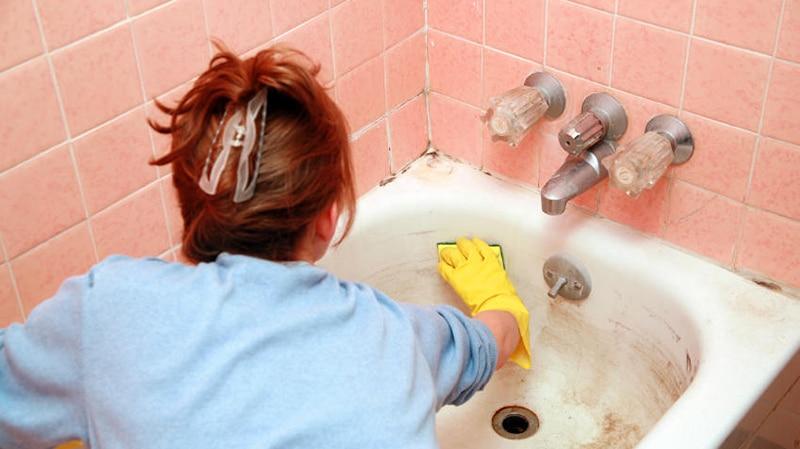
Which means can be used and which cannot?
The shelves of household chemical stores are bursting with an abundance of cutting-edge products, and advertisements vying with each other offer “magic” gels, powders and sprays, promising not only to clean the surface of plumbing fixtures, but also to protect them from germs and new contaminants. What to choose?
- The time-tested Pemolux with soda in its composition is good for equally proven enamel baths. Suitable for well-worn surfaces covered with microcracks.
- “Cillit” will cope well with regular cleaning, but it cannot remove serious stains such as rusty and chalky stains.
- Domestos, which smells of chlorine, is good for all coatings except acrylic spraying. They cannot clean metals either.
- “Cif” and “Comet” are effective (gel is better).Will cope with lime and rust, including on metal parts. It can also be used to clean both tiles and stoves.
Transferred funds not suitable for acrylic bathtubs – a composition without acids, abrasives and aggressive substances is required. “Sun Clean” and “Mr. Chister” have been developed for delicate surfaces.
Important! When choosing a gel or powder, read the composition: it must be “free” from oxalic and hydrochloric acid, aldehydes and alkalis, which are poorly tolerated and resistant to enamel.
By the way! Use toilet cleaners strictly for their intended purpose - they are lethal for baths
The “home” methods listed above include cleaning with mustard powder: Add a little water and rub the surface with the resulting paste. To enhance the effect, you can mix mustard with soda.
Reasonably lazy housewives will appreciate this method: after taking a full bath in the evening, pour it into half a liter of vinegar or pour it out a couple of sachets of citric acid, and drain the water in the morning. All that remains is to rinse the walls with a stream from the shower.
How to get rid of contaminants?
Sometimes a bathtub needs a thorough cleaning, while other “difficult” stains require a particularly powerful “arsenal”. When choosing a product, we focus on three important factors:
- type of pollution;
- coating features;
- compliance with safety requirements.
Important! Plumbing for a housewife similar to the heroine of “Fedorina’s Grief” will require special means. For these cases, formulations with acid - oxalic or hydrochloric - have been developed.
From yellow plaque
After washing, the walls of the bath inevitably become covered with a coating - the remains of soap suds settle, mixed with skin flakes. It is enough to walk over the surface with a sponge and hot water to remove the “side effect” of the hygiene procedure.Over time, the color of the bath and the substances included in shampoos and shower gels will spoil it - you will need cleaning with special products.
It is more difficult with limescale, especially if the water is hard due to the abundance of salts. From time to time, gels with acids that dissolve calcium compounds are shown.
From rust
Being a consequence of the presence of excess iron in the water (or the “antiquity” of the water pipes), rust is one of the most difficult to remove contaminants. In addition to household chemicals, mixtures prepared in the kitchen from available products work well with it: salt and heated vinegar, salt and turpentine (in equal parts), borax and vinegar - apply any mixture to the stains, wipe with a rag. A solution of ammonia applied for 15 minutes or lemon juice squeezed directly onto the stain will dissolve the rust.

From mold
Mold can be removed with vinegar, but it is better to use solvents and antifungal agents. “San Clean for Mold” copes well with it.
Important! Mold in the house requires immediate general cleaning, possibly repairs: fungal spores provoke many diseases, including oncology.
From various stains
Sometimes the surface of the bathtub suffers from accidental mistakes or the consequences of repairs. For example, when providing first aid to a wounded person in the house, it is easy to stain the bathtub with iodine or brilliant green. Baking soda, hydrogen peroxide, alcohol or vinegar will help deal with the annoying stain. The temptation to use powder with abrasive is great, but it is better to overcome it, and in the case of an acrylic bathtub, do not even think in this direction! A potassium permanganate stain will be discolored with hydrogen peroxide or vinegar.
Advice! Try scrubbing the stain with regular toothpaste - most often this helps.
Contamination from building materials (paint, sealant, glue) can only be removed with solvents. But their contact with the enamel surface should be as short as possible: After removing the stain, immediately rinse off the special product!



